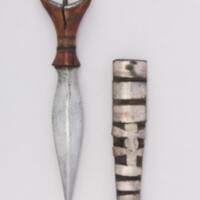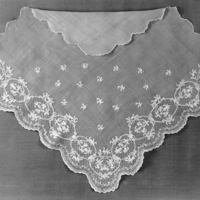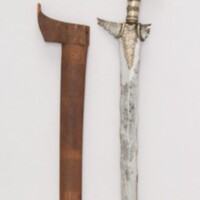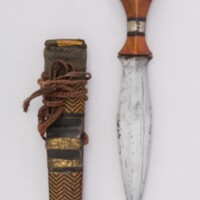Knife (Barong) with Inscriptions
Text
Knife (Barong) with sheath (Knives). Dhū al-fiqār, or the Sword of 'Alī, is the key element of the decoration and symbolism of this barong, a single-edged short sword from Jolo Island in the Sulu Archipelago of the southern Philippines. A stylized depiction of Dhū al-fiqār, inalid in silver, is shown in the center of the barong blade. It is recognizable by its characteristic forked tip, here rendered as two curved prongs.
Also known as the Sword of the Prophet, Dhū al-fiqār was originally the name of one of the personal weapons of the Prophet Muḥammad, which later belonged to his son-in-law, 'Alī. Following Muḥammad's death Dhū al-fiqār attained legendary status, its ownership conferring legitimate temporal and spiritual power. Representations of the sword came to symbolize the victory of Islām and to serve as powerful talismans. The forked tip with which Dhū al-fiqār is invariably depicted seems to have resulted from interpretations of a dream the Prophet was said to have had prior to the battle of Uhud in 625. In the dream he reportedly described the tip of his sword as having a notch or dent. Later, artists represented this as a sword with two points, making it the standard iconographical form found throughout the Islamic world in works of art and on flags, armor, and weapons such as this barong.
The barong is a type of sword unique to the Islamized peoples of the southern Philippines, the Moros. It is distinguished by a heavy single-edged blade of elliptical shape and a gracefully curved pommel that resembles the stylized head of a cockatoo or parrot. The finely carved ivory pommel, silver grip, and plentiful silver inlay decorating the blade of this barong suggest that it was not intended for use in battle but rather as a sign of social status.
Inlaid in Arabic in the center of the Dhū al-fiqār motif is the word "Allāh." Surrounding it are numerous groupings of letters and numbers. These are not intended to be read per so, but were probably chosen in accordance with formulas derived from an Arabic book of talismans. Belonging to the gray area between magic, folk beliefs, and religion, talismans were published in Arabic books as early as the fourteenth century and are still used in some parts of the Islamic world today. Each letter and number in such a system has a mystical significance. Arranged in specific combinations, sometimes in conjunction with Qur'anic passages and other pious phrases, talismans are believed to ward off various dangers. The most common form of talisman is written on a paper, which is folded up, placed in a small container, and worn as an amulet. Talismanic formulas and motifs were used on various types of objects and were often incorporated into the decoration of Islamic sword blades. This baron, however, appears to be unique in terms of Philippine weapons because its decoration combines talismanic inscriptions and the Dhū al-fiqār motif.
Share this



